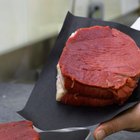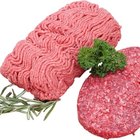Sausage is made from combining various types of ground meat with different combinations of spices and salt. A very necessary component of sausage is the outside hog casing. The casing is the packaging used to hold the combined ingredients together and is made from an animal product.
Hog Casings
Typically, and traditionally, hog casings are made from the intestine of the hog. These casings contain the ground sausage meat. Some casings are made synthetically.
Processing
Natural hog casings are removed during the butchering process. The intestine is cleaned by squeezing and scraping to remove undesirable particles. The casing is then rinsed thoroughly. The casings can be stored by packing them in salt.
Filling
Individual and link sausages are made by pressing the ground meat mixture into a length of hog casing. The casing is then cut and tied off at intervals to form individual sausages.
Consuming
Natural hog casings are edible and are normally consumed with the sausage. Some people prefer to peel away the casing after the sausage is cooked, rather than eating it.
Synthetic
Synthetic casings are made from collagen, although some companies are beginning to produce non-collagen synthetic casings. Synthetic casings come in both edible and inedible forms.
Edible and Inedible
Edible synthetic casings are used in individual sausages and sausage links. Inedible casing is used around soft lunch meats, such as bologna. This should always be removed before consuming the meat.
Related Articles

When Does Salami Spoil?

How is Pepperoni Made?

Types of Portuguese Sausage

What Is Liverwurst Made Out Of?

How to Smoke Sausage in a Meat Smoker

Different Kinds of Cold Cuts

How to Make Salt Brine

How Long Can Smoked Meat Last Without ...

How to Cook Pancetta
How to Debone a Country Ham

What Are the Staple Foods of Scotland?

How to Sugar Cure Bacon

How to Slice Round Steak for Jerky

How to Dry Meat With Salt

Difference Between Genuine Leather ...

How to Sear Ribs

How to Pickle Beef Brisket

How to Peel Plastic From Sausages

What Cuts of Meat Are Used for Ground ...
How to Stuff Edible Collagen Casings
References
Writer Bio
Laura Wallace Henderson, a professional freelance writer, began writing in 1989. Her articles appear online at Biz Mojo, Walden University and various other websites. She has served as the co-editor for "Kansas Women: Focus on Health." She continues to empower and encourage women everywhere by promoting health, career growth and business management skills.